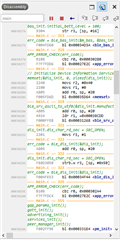I'm trying to implement CLI over BLE UART for one of our company projects. I started from the experimental ble_app_cli example in the SDK. I'm using SDK 15.3.0 on the Nordic PCA10056 SDK board. I keep running into instability problems of various kinds.
In order to narrow down the problem, I decided to simply use the example as is, and see if I can reproduce the issues. For the most part, I end up facing the same problems.
Steps to reproduce:
- start the example in debug mode, so that I can see that's happening.
- connect to the device using an Android BLE Terminal emulator (I use this one https://play.google.com/store/apps/details?id=de.kai_morich.serial_bluetooth_terminal&hl=en&gl=US)
- see the CLI prompt, send led on and led off commands, it all works
- walk away so that the smartphone loses BLE connection
- at least 50% of the times, the PCA10056 device doesn't get the disconnect event, and the device gets into a state where the BLE stack is not communicating anymore. It's also possible to get into the same state using for example the UART functionality of the nRF Toolbox and sending bogus commands
- I added a NRF_LOG_INFO("BLE Cli enabled");/NRF_LOG_INFO("BLE Cli disabled"); after the nrf_cli_init()/uninit for the BLE CLI in ble_evt_handler(), and I can see that the BLE cli gets initialized but never disconnects/uninits, leaving the stack connected even if the phone is disconnected
Is anyone using the CLI over BLE UART? I know I could implement some sort of watchdog, and that the example is only meant as an example, but the reliability I'm seeing so far makes the use of the CLI over the air a bit questionable. Usually the Nordic examples are a lot more robust than this
What am I doing wrong?




